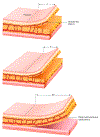Reducing Risks for Local Skin Flap Failure
- PMID: 37001930
- PMCID: PMC10990621
- DOI: 10.1016/j.fsc.2023.01.006
Reducing Risks for Local Skin Flap Failure
Abstract
Local tissue flaps are a fundamental technique in cutaneous reconstruction. Reducing the risk of flap failure is of critical importance. The intrinsic vascularity of a flap is the most important determinant of success. Good surgical techniques, including flap design, delicate tissue handling, and tension-less closure, help reduce the risk of flap compromise. Determining the etiology of compromise, including arterial, venous, hematologic, or infectious, is the first step in salvaging a failing flap. Common causes include pedicle kinking, hematoma, pressure/tension, systemic patient factors, and poor surgical technique. Swift action to restore perfusion or venous outflow through numerous strategies is required.
Keywords: Facial plastic surgery; Flap salvage; Local flaps; Mohs surgery; Plastic and reconstructive surgery; Reconstruction.
Copyright © 2023 Elsevier Inc. All rights reserved.
Conflict of interest statement
DISCLOSURE
The authors have no financial or commercial conflicts of interest to disclose. No funding sources were used to complete this work.
Figures







References
-
- Baker SR. Local Flaps in Facial Reconstruction. Netherlands: Elsevier; 2021.
-
- Janis JE. Essentials of Plastic Surgery. United States. Thieme Medical Publishers, Incorporated; 2014.
-
- Honrado CP, Murakami CS. Wound healing and physiology of skin flaps. Facial Plast Surg Clin North Am 2005;13(2):203–14. - PubMed
-
- Taylor GI, Palmer JH. The vascular territories (angiosomes) of the body: experimental study and clinical applications. Br J Plast Surg 1987;40(2):113–41. - PubMed
-
- McGregor IA, Morgan G. Axial and random pattern flaps. Br J Plast Surg 1973;26(3):202–13. - PubMed

